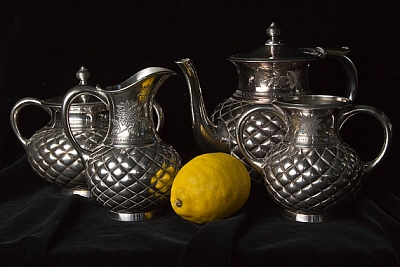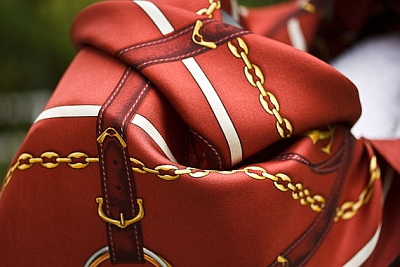The ETSY Factor
December 21st, 2013
Is Etsy.com Changing the Way We See?

Britannia Tea Set, circa 1880
Copyright © 2013, Skip Lombardi
I confess that I’m a serial shopkeeper. Over four decades, I have owned and/or managed retail shops in a score of different locations. I’ve learned how to display, schmooze about, and sell antique Turkish carpets, African baskets, Indian amulets, scrimshaw, potted plants, paintings, and apparel.
Although I was an early Internet adventurer with my own website and multiple email accounts in the mid-90’s, I never took to the format and pricing tiers of eBay.
Then along came Etsy– far easier and cheaper to use than auction-driven “fee-Bay.” I was encouraged to give online the marketing of my stuff another go. And so these days, I also sell my vintage and antique wares via the Internet.
Or perhaps I should rephrase that: I now have customers who know me only as an online merchant.
People who would probably never have found my offerings on eBay or in any of my ever-changing brick-and-mortar retail locations now buy from me. The DO find me in my virtual Etsy shop, where my wares actually look better than they do in my real Main Street shop.
After so many years in the biz, I have no trouble admitting that I am a good merchandiser. Draping a Paisley shawl, hanging a group of paintings, staging vintage cookbooks, wooden spoons, and French casseroles atop an old wooden crate are easy and enjoyable tasks for me. I had great teachers and worked with some masters, most notably one uncle whose work ran the gamut from 1960’s department store displays to his own antique store and homes, which appeared in the pages of major shelter and lifestyle magazines.

Cartier Scarf
Copyright © 2013, Skip Lombardi
So why do I think objects look better online than in my own shop? In a word– photography. One picture really is worth a thousand words, worth more than anything I can say to a customer inside my physical shop. Even though Etsy allows you to write veritable tracts on the items your offer, the visuals are what get viewers to click on your goods. Enticing shots are key (and Etsy lets you post five of each item).b
While most Etsy sellers are amateur photographers, current photo technology gives even novices the tools to create excellent product shots. Furthermore, Etsy’s site design is clean and easy to navigate. Click on any picture: the item fills the screen before you, without the clutter of other things that would compete for your attention in a paper catalogue, a glass display case, on a gallery wall, or on a revolving dress-rack.
Etsy likes to say that its collections are “curated.” While everything from a spice rack to used car lot can now be curated, and the term is woefully overused, there is no denying that Etsy’s visual editorial powers are enormous. Items can be viewed, admired, coveted–and purchased– in isolation.
In my most recent shop, in a bustling New England resort, many visitors said something to the effect of: “What a wonderful shop! So much to see, I don’t know where to look first.”
While those were compliments, they were also alerts. With rents as high as they are, retailers like me are tempted to pack their shops to the rafters. There is always the danger of too much of a good thing. It’s a tricky balance. While shoppers are easily exhausted by merchandise-dense stores, if you edit your bricks-and-mortar shop inventory down to just a few choice pieces and display them in the manner of a couturier or high-end art gallery, a lot of would-be browsers are simply too intimidated to come through the door. But there are no such barriers in the anonymous world of online shopping. You can browse the Tiffany or Hermes websites in your oldest sweatpants.
So could Etsy (with thousands of vendors and millions of items) also overwhelm the casual surfers, those undecided window-shoppers who may not yet know what they might discover or acquire with a few mouse clicks?
That sensory overload doesn’t seem to be happening. Maybe it’s because Etsy gives you that private, minimalist space for viewing– whether you are an insomniac in your pajamas who is shopping during the middle of the night or someone snatching five minutes from a fifteen-minute lunch “hour.”
The walls and carousels of STUFF that funnel you into Nordstrom, Macy’s, or a dollar store bear little resemblance to the serene Etsy virtual storefronts, each with no more than 28 tile photos, as orderly as a sheet of postage stamps.
I think there’s been a change in our brains. Whether we are simply aspirational Etsy visitors or are actual buyers, sites like Etsy have trained us to see differently.



